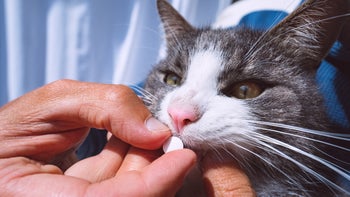
9 Medications, Treatments, and Remedies for Cat Arthritis
Key takeaways:
Arthritis happens when the cartilage between a cat’s joints wears away because of age or injury.
Your cat’s pain can be managed with a combination of treatments, such as supplements, medication, and physical therapy.
Signs of arthritis in cats include struggling to get in and out of the litter box and becoming reclusive.
Table of contents

Like dogs and humans, cats can develop arthritis in their joints. This happens when the cartilage between their bones is worn away.
Arthritis often causes pain. But cats with this condition can usually live normal lifespans with good pain management. Let’s take a look at the treatment options for cats with arthritis.
Treatments and remedies for cats with arthritis
Arthritis in cats is typically addressed with a combination of treatments to slow the disease. Here are nine things your vet might recommend.
Search and compare options
1. Solensia
Using certain pain medications long term in cats isn’t recommended for arthritis, because cats’ livers process medications slowly. But a newer monoclonal antibody treatment called Solensia (frunevetmab) was approved by the FDA in 2022. It’s a monthly injection specifically for long-term use in cats with arthritis. It defends against a substance in the body that causes chronic pain.
Solensia injections must be given by a veterinarian. Cats with an allergy to frunevetmab shouldn’t be given Solensia. Ask your vet if your cat would benefit from this treatment.
2. Other medications
Other medications may also be used to control pain related to cat arthritis. Nonsteroidal anti-inflammatory drugs (NSAIDs) are sometimes prescribed for cats. These medications quickly reduce inflammation in the body. The NSAIDs used for cats are:
Meloxicam (Metacam)
Robenacoxib (Onsior)
Only one NSAID can be used at a time. NSAIDs are generally used for only a short time in cats because they can cause serious side effects.
Other types of pain relievers can be used for cats with arthritis. These pain medications include:
Amantadine (Symmetrel)
Signs of pain: Cats are good at hiding their pain. But if you learn to recognize these common pain symptoms, you’ll be able to decode cat pain in no time.
Solensia for cats: Solensia (frunevetmab) is often a first-choice treatment for cat arthritis. Learn how this monthly injection works to treat arthritis in cats.
Vet visits for your cat: Cats should visit their veterinarian for a regular checkup at least once a year. Here’s why it’s important for your cat’s health.
Your veterinarian will use their judgment to decide how long your cat should take any of these medications. None are available over the counter for cats. Over-the-counter pain medications are dangerous for cats and shouldn’t be given to them.
3. Supplements
Supplements may be recommended to manage arthritis pain in cats. But it can take several weeks to see results. And supplements often provide only mild relief from arthritis pain.
Supplements that may help include:
Chondroitin sulfate
Creatine
Glucosamine
Methylsulfonylmethane (MSM)
Read more like this
Explore these related articles, suggested for readers like you.
Most of these supplements work by helping a cat’s body repair cartilage. Creatine is a little different. It supports muscle strength and endurance.
There are other supplements that may help with inflammation. Their benefits are also mild, and they vary in how fast they act. These supplements include:
Avocado-soybean unsaponifiables
Cannabinoids
Dried milk proteins
Green-lipped mussel extract
Omega-3 fatty acids
Polyphenols like green tea extracts and turmeric
Supplements aren’t regulated by the FDA, so it’s important to shop for high-quality brands. Your veterinarian will help you pick ones that best fit your cat’s needs.
4. Weight loss
Cats who are overweight experience arthritis more often than cats who are a normal weight. The extra weight puts more pressure on the joints.
You can help your cat lose weight through diet and exercise. There are therapeutic diets specifically for weight loss. Some are also formulated to provide support for arthritis. Your veterinarian will help you decide which diet your cat should follow and the proper portion sizes to give them.
You can also help your cat lose weight by encouraging them to exercise through play. Some things you can do to keep your cat active include:
Provide them with cat trees to climb on.
Hide their meals around the home.
Install a “catio” if you have a backyard.
Make an obstacle course.
Play chase with a laser pointer.
Give them interactive toys to play with.
Train them to walk on a leash.
Use puzzle feeders for meals.
It might take time to figure out which activities your cat enjoys most.
5. Physical therapy
Physical therapy can be part of a long-term plan to manage your cat’s pain. Physical therapy for arthritis has multiple goals:
Increase a cat’s ability to move
Rebuild function and strength in muscles and joints
Improve balance
A therapist uses their hands to take your cat through exercises, such as passive range of motion (PROM) exercises. These exercises help improve stiff muscles, circulation, and retained fluid.
6. Laser and magnetic therapy
Therapies using lasers or pulsing magnetic signals can help reduce a cat’s pain. There are two options to choose from for cats:
Laser therapy: A noninvasive laser light is used to penetrate tissue to promote healing and circulation, and to decrease inflammation and pain.
Targeted pulsed electromagnetic field (tPEMF) therapy: This therapy reduces inflammation and pain by sending a signal into the tissue to trigger it to repair itself.
7. Exercise therapy
Different exercises can be used for different arthritis-related issues in cats, such as lack of endurance or poor balance. Exercise examples include walking on slopes, through obstacles, or on uneven ground.
Another exercise option for cats is hydrotherapy. Exercises in water — such as an underwater treadmill or swimming — are used to improve a cat’s range of motion, strength, and mobility. The water helps reduce the impact on the joints.
Not all cats will tolerate every form of therapy, especially hydrotherapy. Work with your veterinarian to determine what options will be best for your cat.
8. Environmental modifications
As their arthritis progresses, your cat might have a harder time getting around the home. You can make modifications to make them more comfortable. These include:
Carpeted ramps or steps to their favorite spots
Litter boxes with low walls
Orthopedic beds
Raised dishes for meals and water
Rugs or mats covering slippery flooring
If you have stairs, keeping resources for your cat — such as water and litter boxes — on every floor can be beneficial.
9. Surgery
Your cat’s arthritis could have an underlying cause, such as a knee injury or hip dysplasia. Your veterinarian might suggest surgery to correct the issue and improve stability. Surgery options include hip replacement for hip dysplasia and joint fusion for arthritis in the ankles.
What causes arthritis in cats?
When the cartilage in joints is worn away, the bones grind against each other, causing pain. Different things can cause arthritis, including:
Increasing age
Hip dysplasia
Injury
Weight
Arthritis can develop at any age. But it’s more common in cats who are at least 10 years old.
Signs of arthritis in cats
It can be hard to tell when a cat is in pain. But they do show signs of pain, such as:
Becoming reclusive
Acting irritable
Slowing down
Struggling to get in and out of the litter box
Struggling to go up and down stairs
Being unable to groom their coat
If your cat has any of these symptoms, it might be best to take them to the veterinarian. A prompt diagnosis will help your cat feel better quicker.
How is arthritis in cats diagnosed?
Arthritis in cats is diagnosed based on symptoms, physical exams, and diagnostic images, if needed. During an exam, your veterinarian will likely feel for:
Swelling in your cat’s joints
Fluid within the joints
Lack of range of motion
Diagnostic images that might be performed include X-rays and CT scans. These images can show:
Bone spurs
Elbow dysplasia
Hip dysplasia
Joint disorders
Your veterinarian will determine if your cat needs further testing to diagnose their arthritis.
The bottom line
Arthritis occurs when the cartilage between bones gets worn away. Cats with arthritis might have trouble doing normal activities like grooming their coat and getting in and out of the litter box.
Treating arthritis usually involves a combination of methods, such as medication, supplements, physical therapy, and weight loss. Certain injuries might need surgery to be corrected. There are also ways you can modify your home to make life easier for your cat.
Why trust our experts?



References
Brooks, D., et al. (2014). 2014 AAHA weight management guidelines for dogs and cats. Journal of the American Hospital Association.
Brooks, W. (2023). Medications for degenerative arthritis in dogs and cats. Veterinary Partner.
Cornell Feline Health Center. (n.d.). Is your cat slowing down? Cornell University College of Veterinary Medicine.
Goldberg, M. E. (2016). Feline physical rehabilitation. Today’s Veterinary Nurse.
Huntingford, J. L. (2020). Managing the pain of feline degenerative joint disease. Today’s Veterinary Practice.
Jaffe, M. (2023). Diagnosis and management of feline osteoarthritis. Today’s Veterinary Practice.
Little, S. (2015). Stiff, sore cats: Taming feline arthritis. World Small Animal Veterinary Association World Congress Proceedings.
Lundgren, B. (2019). Arthritis in dogs and cats: What can be done? Veterinary Partner.
U.S. Food and Drug Administration. (2022). Get the facts about pain relievers for pets.
U.S. Food and Drug Administration. (2025). Osteoarthritis in cats: More common than you think.
Veterinary Partner. (n.d.). Signs of pain in cats.





























